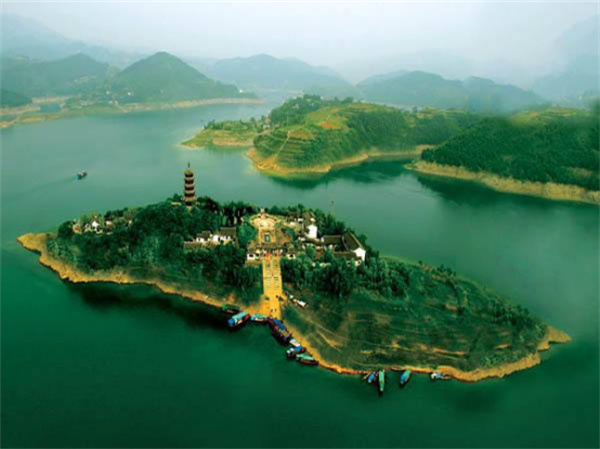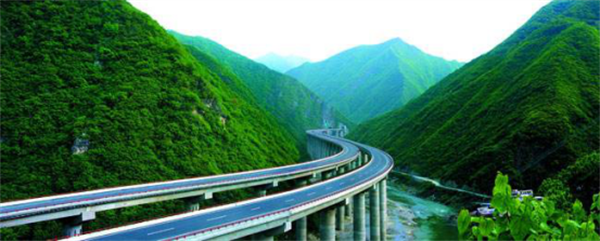- CURRENT LOCATION: HOME
- >> About Shaanxi
- >>
- Cities
Ankang
2021-08-27 15:00:00 , Source : The Government Website of Shaanxi ProvinceOfficial Website: http://www.ankang.gov.cn
Ankang now governs 1 district (Hanbin District), 1 county-level city (Xunyang City) and 9 counties: Hanyin County, Shiquan County, Ningshan County, Ziyang County, Langao County, Pingli County, Zhenping County, and Baihe County. The seventh census data shows that Ankang has a resident population of 2,493,436 as of November 1, 2020. With the completion of Xi'an-Ankang Expressway and Xi'an-Ankang Railway, Ankang is fully integrated into the 2-hour economic circle of Xi'an.

Location
Due to its location south of the Qinling mountains, Ankang is geographically considered to be part of southern China, yet, on administrative terms, as Shaanxi is officially part of Northwestern China. Ankang is located in the southeastern part of Shaanxi, north of the Daba Mountains and south of the Qinling mountains. Measuring 200km (120mi) from east to west and 240km (150mi) from north to south, the prefecture-level city of covers an area of 23,534.5 km²(9,100sqmi). The Han River (Hanshui) crosses it from west to east, forming a natural landform of "a plain between two mountains".
Situated in the geometric center of three Economic Districts (Xi’an of Shaanxi province, Wuhan of Hubei Province, and Chongqing Municipality), Ankang enjoys unique geographic advantages. Between inter-provincials, it adjoins with Hubei Province in the east, Sichuan Province and Chongqing Municipality in the south. In Shaanxi Province, Ankang borders the capital city of Xi’an and Shangluo in the north and Hanzhong in the west.
Being in the region of continental subtropical monsoon climate, Ankang has four distinctive seasons with abundant rain, long frost-free periods and obvious vertical regional climate. The annual average temperature is around 12°C in Ningshan and Zhenping County and about 15°C in other counties. The total number of annual sunshine hours is between 1495.6 and 1836.2. The number of rainfall is between 750 and 1100 millimeters each year. The frost-free period is as long as 210-270 days, which lasts on average more than 8 months. The main features of the climate: a cold winter with little rain and snow; a rainy summer with drought; a warm and dry spring; a cool and wet fall with much constant rain. The main severe weather is summer drought, rainstorm and constant rain.

History and culture
Ankang has a long history, with a recorded history of more than 3,000 years and cultural history which can be traced back to the Stone Age. Ankang County was set up in the first year of Taikang in Western Jin Dynasty (A.D. 280); the name AnKang means "having abundant harvest and happy forever, being peaceful and healthy". In the third year of Feidi in Western Wei Dynasty (A.D. 554), it was changed to "Golden State" because the Yuehe Chuandao Area in Ankang produces flake gold. Control of the area was often contested. After the founding of the People's Republic of China, the Ankang Office of the Shaanxi Province People's Government was set up in 1950, growing to become the Ankang Area Civic Administration in 1979. In 2001, Ankang Area became Ankang City with a city-level administration.
Ankang's history and culture is nearly the same as Chinese culture, but with distinctive characteristics and geographical features marked by its diversity, which integrates east and west, north and south. It is influenced by Shaanxi culture, Chinese culture and Diqiang culture, with elements Bashu and Jinchu culture to form the present-day Han River culture after thousands of years of assimilation and fusion. The operas of Ankang have a long history, with nearly ten varieties, of which Han Opera is the best and most mature. According to incomplete statistics, the operas of Ankang consist of more than a thousand traditional plays. It is said that the tone of Beijing Opera originates from Han Opera. Ankang is well-known as "the land for folk songs" and was named as "the land for folk songs in China" by the Ministry of Culture in 2003. Ziyang folk songs has became a cultural brand of Ankang. Ziyang folk songs and the Han tune "Erhuang" have been listed on the Intangible Cultural Heritage List by the State Council.

Natural resources
Locating at a rare zone abundant in subtropical resources in the northwest of China, Ankang is a intermediate zone between north and south of China and a transition zone of different climate whose unique geographical features makes it to own beautiful natural scenery and rich tourism resources, which gives a high value and a good prospect to develop it, such as developing the tourism of Qinba and Han River scenery and the tourism for holidays and leisure. It is a vivid description of Ankang's scenery that "Ankang contains the beautiful scenery in the south of China, as well as the magnificent view of Qinling and Ta-pa Mountains." Now Ankang has exploited 32 scenic areas and 78 scenic spots, among which 29 places have higher value to exploit, including some historic and scenic sites at the provincial level such as Nangong Mountain National Forest Park, Ying Lake and Xiangxi Hole, and lots of historic and scenic sites or tourism projects such as Qianjia Ping, the origin of Shen River, Pinghe Liang, rafting on the Lan River and so on. Ankang also has four national forest parks and seven forest parks at the provincial level.

Ankang is the subtropics continental monsoon climate with assembled biological resources. known as "the mountain of treasure in Qinba area", Ankang has more than 3300 kinds of biological species. There are 2157 kinds of trees, among which katsura tree, horse chestnut, Liriodendron, yew, ginkgo, Cephalotaxus, camphor, nanmu, wingceltis and so on are rare or unique in China, especially Davidia involucrata Baill (Also known as Chinese dove tree) growing in Zhenping County is called as living fossil 250 million years ago which is a rare species in the world. Ankang has a total of 430 kinds of wild animals, of which 34 were classified as national protective rare animals. Ankang is rich in Chinese herbal medicines, with more than 1290 kinds of species. The output of cocoon, Codonopsis pilosula, tea, raw Chinese lacquer, musk tops Shaanxi and the output of raw Chinese lacquer is well-known in China. The development of Chinese herbal medicines mainly on Gynostemma pentaphylla, saponin and puerarin has formed industrial groups with certain size. Ankang's tea has a long production history, which is one of seven major tea-planted areas in China. There are 9 counties or districts produce tea, among which Ziyang, Liping, Hanbin, Langao, Han Yin and Shiquan are the main tea-producing areas. Ankang is also the largest silkworm and silk production base in Shaanxi, even in the northwest of China whose cocoon output accounts for more than 80% of Shaanxi Province. Ankang is an important base for forest and animal husbandry. The grassland covers an area of 3,140,550 mu and the theoretical animal number of the grasslands is 3,445,000. The forest area is 2,132 mu and the forest coverage of Ankang is 56.5%. The stumpage has reached 55,540,000 cubic meters, accounting for 20.6% of Shaanxi's.

The plant base of green industry covers an area of more than four million mu. The output of cocoon makes up 80% of the total output of cocoon in Shaanxi. Turmeric, Gynostemma pentaphylla and the tea enriched in selenium have obtained the formulation right of the national standard. The industrial systems of Qinba medicine, green food, Ankang silk, Han River hydropower, Jinzhou minerals and so on have been formed basically. Taking "Using Ecotourism to Promote Ankang" as the subject, highlight three traveling brands of "Han River's Culture, Qinba Scenery, Customs in Ankang", the tourism industry is full of vigor and vitality. Ankang carry out three projects of afforestation, ecological protection and environmental control to maintain and develop a good ecological environment with blue sky and white clouds, green mountains and blue waters in Ankang.

About 65 kinds of metals and non-metallic minerals have been found in Ankang, and 32 kinds have been proven valuable in the mining industry. The reserves of mercury, antimony, lead, zinc, gold, barite, witherite, slate tile, cement, limestone, turquoise are on the first rank of China or Shaanxi Province. Furthermore, the reserves of mercury and slate tile tops China, and the reserves of antimony, alluvial gold, barite, witherite, slate tile are on the top of Shaanxi. Mercury-antimony mine in Xunyang, the largest mercury-antimony mine in China, has a good market prospect.
Transportation
A three-dimensional communication network has been initially formed consisting of civil aviation, railways and highways. Ankang airport lies only 17 kilometers west to the city center. There are non-stop flights from Ankang to Xi'an, Wuhan and other places every day. Five railways of Yangpingguan-Ankang, Xiangfan-Chongqing, Xi'an-Ankang, Xi'an-Chongqing (double track), Ankang-Wuhan (double track) are the important juncture of railway traffic among central south, north, southwest and northwest of China, of which Ankang can reach Beijing, Shanghai, Zhengzhou, Xi'an, Chengdu, Chongqing, Wuhan, Fuzhou, Qingdao and other big cities respectively in one day. There are two national highways (No.316 and No.210) and two expressways run through (Xi'an-Hanzhong and Xi'an-Ankang) Ankang.
At present, the whole city reaches a common understanding of investment and development and the social environment of favoring, valuing, stabilizing and enriching the business circle. We believe that Ankang will be the ideal choice for domestic and foreign investors. Investing in Ankang is just an investment in Green, which is also the investment for future.

Government Organizations



Other Links

Copyright@www.shaanxi.gov.cn All Rights Reserved
Registration Number:陕ICP备10004160号
